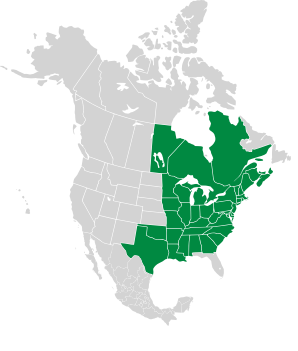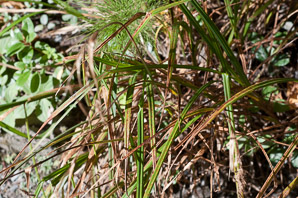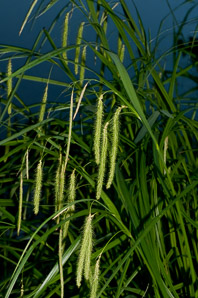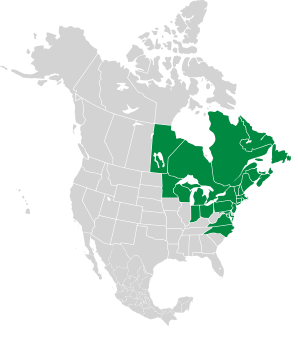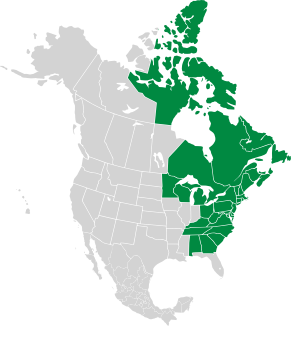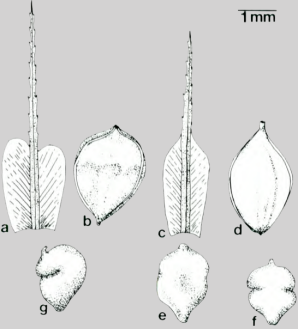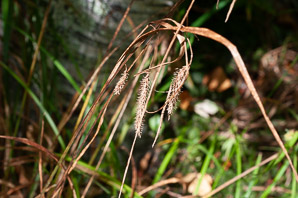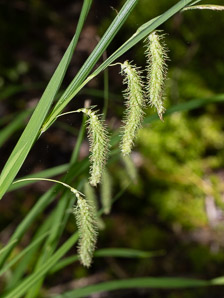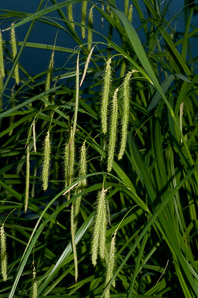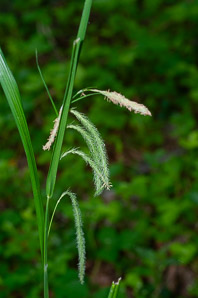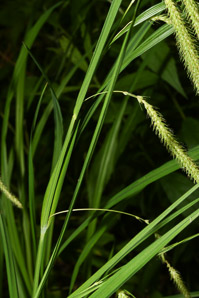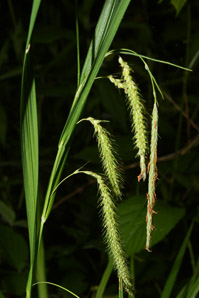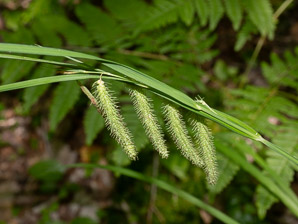
|
Carex crinita Lam. Drooping sedge, long-haired sedge, fringed sedge
These sedges are native to North America. They have an affinity for wet, freshwater soils. Plants: Drooping sedges are up to 4½′ (1.4 m) high, though I rarely see them that large, with stems that are triangular in cross-section. They usually appear in tufts. Flowers/seeds: Each stem supports 3-5 narrow, cylindrical drooping carpellate seed spikes up to 4½″ (11 cm) in length and ¼″ (7 mm) in diameter. Tiny, white, filament-like flowers are visible on the carpellate spikes in Photo 6. The precise shape of the perigynia and pistillate scales on the carpellate spikes are an identifying feature. Each stem also contains up to 3 staminate spikes. Although past their prime, you can make out the male pollen-bearing structures on the staminate spikes in Photo 8. Leaves: Leaves are ribbed, grass-like, M- or U-shaped in cross section, up to ⅜″ (1 cm) wide. Carex crinita is easily confused with, and often found near, C. gynandra. “Easily confused” is an understatement: distinguishing these species requires a hand lens or scanner and a penchant for obscure botanical terminology. Scholarly papers have been written to provide evidence that they really are different. |
1 · 9/20/2009 · Wild Gardens of Acadia, Acadia National Park, Bar Harbor, Maine · ≈ 14 × 9″ (35 × 23 cm) 2 · 6/2/2010 · J. Harry Rich State Forest, Groton, Massachusetts · ≈ 9 × 14″ (23 × 35 cm) |
||||||||||||||||||||||||||||
|
| |||||||||||||||||||||||||||||
Carex arctata |
You are here Carex crinita |
Carex gynandra |
|||||||||||||||||||||||||||
|---|---|---|---|---|---|---|---|---|---|---|---|---|---|---|---|---|---|---|---|---|---|---|---|---|---|---|---|---|---|
| Common Name |  |
 |
 |
||||||||||||||||||||||||||
| Plant | Occurring in dense tufts, plants are up to 3′ (1 m) high. | Up to 4½′ (1.4 m) tall. | Up to 4½′ (1.4 m) tall. | ||||||||||||||||||||||||||
| Flowers | Male (staminate) and female (pistillate) spikes are separate. The topmost spike is unisexual, staminate, ⅞-3 ⨉ 1/16-⅛″ (2.5-8 cm ⨉ 3-4 mm). 2-5 pistillate (also called carpellate) spikes appear lower on the stem. Each spike is up to 3″ (8 cm) long, and slender. Young spikes point upward, but they droop with age. | Drooping narrow cylindrical heads up to 4½″ (11 cm) long and ¼″ (7 mm) in diameter. Carpellate scales are pale, truncate to notched at apex, with rough-textured awns. 1-3 staminate spikes per stem. | 2-5 carpellate narrow, cylindrical spikes per stem. Each spike is ⅞-4″ (2.4-10 cm) long, ⅛-¼″ (3-9 mm) in diameter. Scales on the carpels are pale- to copper brown. There are 1-3 staminate spikes per stem. | ||||||||||||||||||||||||||
| Leaves | Basal or nearly so. Grasslike leaves are ⅛-⅜″ (3-10 mm) wide. At the base, they are encased in a sheath that is pink to reddish purple. Younger leaves have an ‘M’ or ‘W’-shaped cross-section. | M or U-shaped in cross-section, ⅛-⅜″ (4-10 mm) wide. | ⅛-⅜″ (4-10 mm) wide, U-shaped. | ||||||||||||||||||||||||||
| Stem | Triangular stem cross-section. Basal leaf sheaths are smooth. | Rough-textured, with a triangular cross-section. Basal leaf sheaths are rough. | |||||||||||||||||||||||||||
| Fruit | Achenes are ~1/16″ long ⨉ 1/32-1/16″ wide (1.7-2.6 ⨉ 0.8-1.7 mm). | Perigynia are spreading, slightly inflated obovoid (widest above the middle and truncate), 1/16-⅛″ (2-4 mm) long. | Perigynia are oval-shaped, tapering to a small beak. | ||||||||||||||||||||||||||
| Range/ Zones |
|
|
|
||||||||||||||||||||||||||
| Habitats | Rich, damp forested areas. | Bottomland prairies, moist upland prairies, margins of bodies of water, spring branches, fens. | Marshes, wet forests, swamps, seeps, and roadside ditches. Perhaps a little more weedy and abundant in acidic soils than C. crinita. | ||||||||||||||||||||||||||
| Type | Wild | Wild | Wild | ||||||||||||||||||||||||||
Carex gracillima

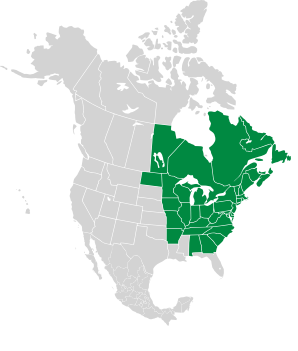
Representative perigynia, achenes, and scales. Carex crinita (left): pistillate scale (a), perigynium (b), achene (g); C. gynandra (right): pistillate scale (c), perigynium (d), achenes (e, g). Standley, Lisa A., “A Clarification of the Status of Carex crinita and C. gynandra,” Rhodora, Journal of the New England Botanical Club, 1983, Vol. 85, No. 841. 
Online References:
The Lady Bird Johnson Wildflower Center
The Lady Bird Johnson Wildflower Center
The U.S. Geological Survey's Northern Prairie Wildlife Research Center
References:
3 · 9/20/2009 · Wild Gardens of Acadia, Acadia National Park, Bar Harbor, Maine · ≈ 11 × 7″ (27 × 18 cm) 
4 · 6/22/2023 · Florida Lake Park, Freeport, Maine 
5 · 6/2/2010 · J. Harry Rich State Forest, Groton, Massachusetts · ≈ 9 × 14″ (23 × 35 cm) 
Carex crinita description by Thomas H. Kent, last updated 8 Sep 2023.
© FloraFinder.org. All rights reserved.
6 · 5/20/2012 · J. Harry Rich State Forest, Groton, Massachusetts · ≈ 6 × 9″ (14 × 22 cm) ![]() ID is uncertain
ID is uncertain 
7 · 5/31/2016 · J. Harry Rich State Forest, Pepperell, Massachusetts 
8 · 5/31/2016 · J. Harry Rich State Forest, Pepperell, Massachusetts 
9 · 6/22/2023 · Florida Lake Park, Freeport, Maine 
Range:
